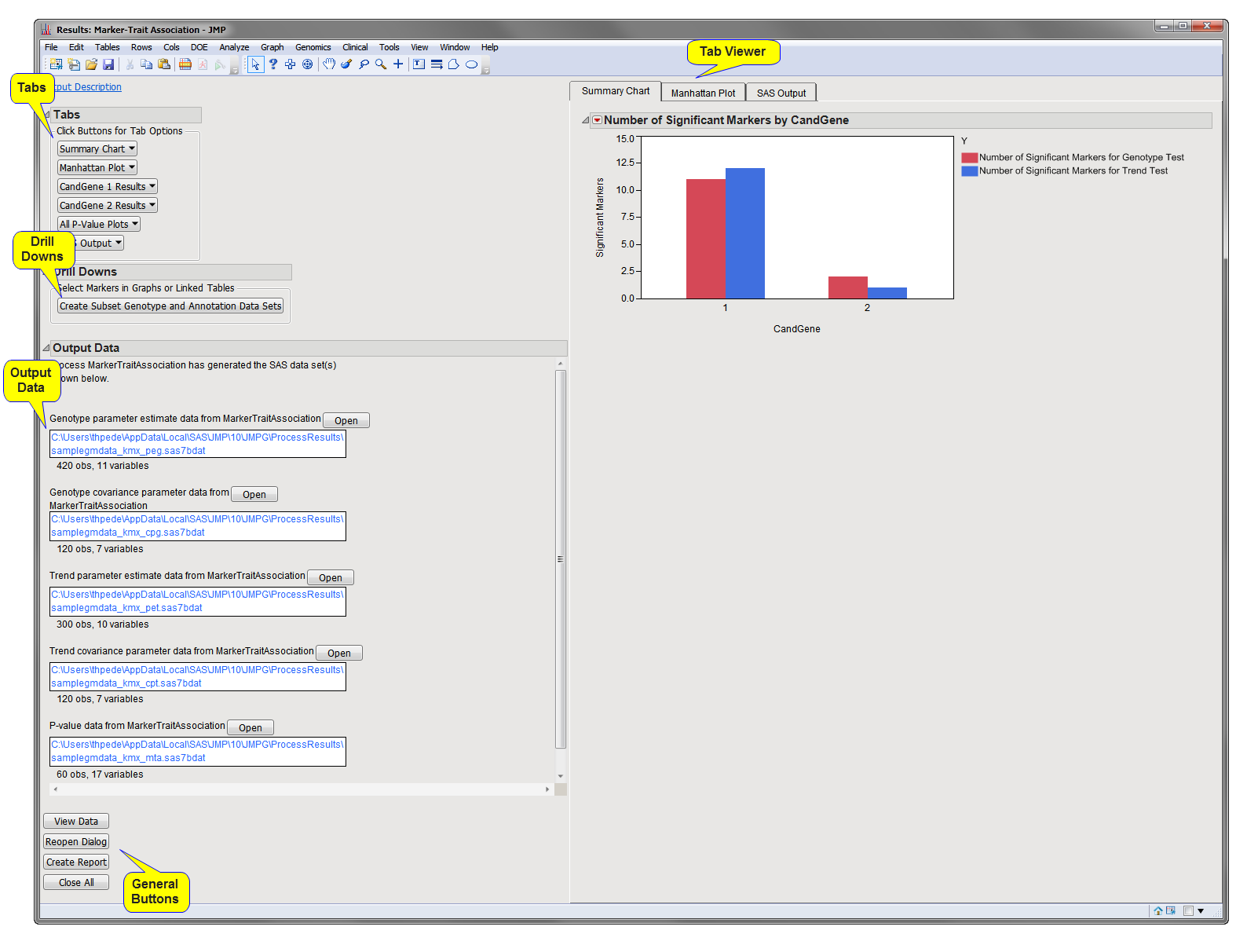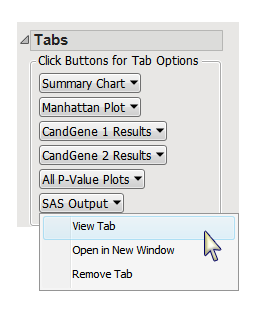Running this process using the
GeneticMarkerExample_KMatrix
sample setting generates the tabbed
Results
window shown below. Refer to the
Marker-Trait Association
process description for more information. Output from the process is organized into tabs. Each tab contains one or more plots, data panels, data filters, and so on. that facilitate your analysis.
The
Results
window contains the following panes:
This pane enables you to access and view the output plots and associated data sets on each tab. Use the drop-down menu to view the tab in the
Tab Viewer
pane, open the tab in a new window, or remove the tab and its contents from the
Tab Viewer
pane.
|
•
|
Summary Chart
: When there are multiple annotation groups (
chromosomes
or genes, for example), this tab displays the number of significant markers in each annotation group for each test. Separate
bar charts
are shown for each
BY group
when any
BY variables
are specified. This tab is open by default.
|
|
•
|
Manhattan Plot
: When there are multiple annotation groups (chromosomes or genes, for example), this tab displays a scatter plot of the
p-values
across all annotation groups.
|
|
•
|
Annotation Group Results
: When there are multiple annotation groups (chromosomes or genes, for example), a separate
Results
tab with an
overlay plot
of
p
-value by chromosome location is created for each annotation group. In this example, there are two annotation groups (CandGene 1, and CandGene 2) and, thus two Annotation Group Results tabs (
CandGene 1 Results
and
CandGene 2 Results
).
|
|
•
|
All P-Value Plots
: When there are multiple annotation groups (chromosomes or genes, for example), the
All P-Value Plots
tab shows all the
p
-value plots from the
Annotation Group Results
tabs in a single display.
|
Note
: When an annotation group
variable
is not specified or there is only one annotation group, the tab is named
P-Value Plot
and contains an overlay plot of
p
-value by chromosome location for all markers.
|
•
|
All Trends Odds Ratio Plots
: : If the
Calculate trend odds ratios
check box was checked and there are multiple annotation groups (chromosomes or genes, for example), this tab shows all the odds ratio
volcano plots
.
|
|
•
|
SAS Output
: This tab displays the SAS output from the MIXED, GLIMMIX, LOGISTIC, or PHREG procedure in SAS/STAT, which is run to fit the
model
. Information about estimates for
fixed effects
and
covariance
parameter estimates is included in this output as well as fit statistics for the model.
|
|
•
|
Create Subset Genotype and Annotation Data Sets
: Select points from the
p
-value plots and click
to open the
Subset and Reorder Genetic Data
process to create
genotype
and annotation subset data sets.
|
Note
: This action button is not available if either multiple
traits
or any By Variables are selected.
|
•
|
GenBank Nucleotide
: Select points or rows and click
to opens a browser window directed to a GenBank Nucleotide search for the selected molecular entities.
|
|
•
|
UniGene Database
: Select points or rows and click
to access information from the Unigene database for selected genes or markers
|
|
•
|
AceView Database
: Select points or rows and click
to access information from the ACEView database for selected genes or markers.
|
|
•
|
Plot Trait by Genotype
: Select markers from the
p
-value plots and click
to view each marker's genotype
distribution
for each of the
Trait Variables
values.
|
Note
: This action button is available only when numeric genotypes are specified.
|
•
|
View Venn Diagram of Significant Markers by Trait for the Test Below
: Click either
or
to view a
Venn diagram
showing significant
association
according to that test for the individual traits and the
MANOVA
test, either for all markers or those in a particular annotation group, so you can easily identify what markers are significant for one or more traits.
|
Note
: This option is available only when two or more
Trait Variables
are specified.
|
•
|
Genotype Parameter Estimate Data Set
: This data set contains the estimates and
test statistics
for the fixed effects included in each
regression
model testing for association, including the marker genotype treated as a categorical variable, and is generated when the
Genotype
test is performed. The name of this data is set is given by the
Output File Prefix
, or input data set name if none given, with the suffix
_peg
. Click
to view the data set.
|
|
•
|
Genotype Covariance Parameter Estimate Data Set
: This data set contains the estimates for the covariance parameters (
K matrix
and/or
random effects
) included in each regression model testing for association, including the
residual
. This data set is generated when the
Genotype
test is performed and random effects are specified. The name of this data is set is given by the
Output File Prefix
, or input data set name if none given, with the suffix
_cpg
. Click
to view the data set.
|
|
•
|
Trend Parameter Estimate Data Set
: This data set contains the estimates and test statistics for the fixed effects included in each regression model testing for association, including the counts of each
allele
in the genotype treated as a continuous variable. This data set is generated when the
Trend
test is performed. The name of this data is set is given by the
Output File Prefix
, or input data set name if none given, with the suffix
_pet
. Click
to view the data set.
|
|
•
|
Trend Covariance Parameter Estimate Data Set
: This data set contains the estimates for the
covariance
parameters (
K
matrix and/or random effects) included in each regression model testing for association, including the residual. This data set is generated when the
Trend
test is performed and random effects are specified. The name of this data is set is given by the
Output File Prefix
, or input data set name if none given, with the suffix
_cpt
. Click
to view the data set.
|
|
•
|
P
-value Data Set: This data set contains all the columns from the
annotation data set
, plus the test statistics and
p
-values from the tests performed. This data set can be used as the annotation data set for subsequent processes to accumulate results from multiple processes into a single data set. The name of this data is set is given by the
Output File Prefix
, or input data set name if none given, with the suffix
_mta
. Click
to view the data set.
|
For detailed information about the files and data sets used or created by JMP Life Sciences software, see
Files and Data Sets
.
|
•
|
Click
to reveal the underlying data table associated with the current tab.
|
|
•
|
Click
to reopen the completed process dialog used to generate this output.
|
|
•
|
Click
to generate a
pdf
- or
rtf
-formatted report containing the plots and charts of selected tabs.
|
|
•
|
Click
to close all graphics windows and underlying data sets associated with the output.
|

